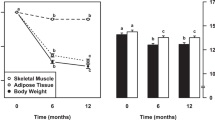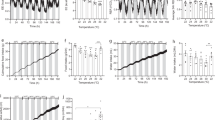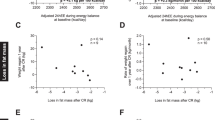Abstract
Background/Objectives:
In small studies, a thrifty human phenotype, defined by a greater 24-hour energy expenditure (EE) decrease with fasting, is associated with less weight loss during caloric restriction. In rodents, models of diet-induced obesity often have a phenotype including a reduced EE and decreased core body temperature. We assessed whether a thrifty human phenotype associates with differences in core body temperature or body composition.
Subjects/Methods:
Data for this cross-sectional analysis were obtained from 77 individuals participating in one of two normal physiology studies while housed on our clinical research unit. Twenty-four-hour EE using a whole-room indirect calorimeter and 24-h core body temperature were measured during 24 h each of fasting and 200% overfeeding with a diet consisting of 50% carbohydrates, 20% protein and 30% fat. Body composition was measured by dual X-ray absorptiometry. To account for the effects of body size on EE, changes in EE were expressed as a percentage change from 24-hour EE (%EE) during energy balance.
Results:
A greater %EE decrease with fasting correlated with a smaller %EE increase with overfeeding (r=0.27, P=0.02). The %EE decrease with fasting was associated with both fat mass and abdominal fat mass, even after accounting for covariates (β=−0.16 (95% CI: −0.26, −0.06) %EE per kg fat mass, P=0.003; β=−0.0004 (−0.0007, −0.00004) %EE kg−1 abdominal fat mass, P=0.03). In men, a greater %EE decrease in response to fasting was associated with a lower 24- h core body temperature, even after adjusting for covariates (β=1.43 (0.72, 2.15) %EE per 0.1 °C, P=0.0003).
Conclusions:
Thrifty individuals, as defined by a larger EE decrease with fasting, were more likely to have greater overall and abdominal adiposity as well as lower core body temperature consistent with a more efficient metabolism.
This is a preview of subscription content, access via your institution
Access options
Subscribe to this journal
Receive 12 print issues and online access
$259.00 per year
only $21.58 per issue
Buy this article
- Purchase on Springer Link
- Instant access to full article PDF
Prices may be subject to local taxes which are calculated during checkout



Similar content being viewed by others
References
Weyer C, Vozarova B, Ravussin E, Tataranni PA . Changes in energy metabolism in response to 48 h of overfeeding and fasting in Caucasians and Pima Indians. Int J Obes Relat Metab Disord 2001; 25: 593–600.
Thearle MS, Pannacciulli N, Bonfiglio S, Pacak K, Krakoff J . Extent and determinants of thermogenic responses to 24 hours of fasting, energy balance, and five different overfeeding diets in humans. J Clin Endocrinol Metab 2013; 98: 2791–2799.
Garrow JS, Warwick P, Blaza S, Ashwell M . Predisposition to obesity. Lancet 1980; 315: 1103–1104.
Miller DS, Mumford P, Stock MJ . Gluttony 2. Thermogenesis in Overeating Man. Am J Clin Nutr 1967; 20: 1223–1229.
Ravussin E, Schutz Y, Acheson KJ, Dusmet M, Bourquin L, Jéquier E . Short-term, mixed-diet overfeeding in man: no evidence for “luxuskonsumption”. Am J Physiol 1985; 249: E470–E477.
Reinhardt M, Thearle MS, Ibrahim M, Hohenadel MG, Bogardus C, Krakoff J et al. A human thrifty phenotype associated with less weight loss during caloric restriction. Diabetes 2015; 64: 2859–2867.
Klaus S, Münzberg H, Trüloff C, Heldmaier G . Physiology of transgenic mice with brown fat ablation: obesity is due to lowered body temperature. Am J Physiol 1998; 274: R287–R293.
Lateef DM, Abreu-Vieira G, Xiao C, Reitman ML . Regulation of body temperature and brown adipose tissue thermogenesis by bombesin receptor subtype-3. Am J Physiol Endocrinol Metab 2014; 306: E681–E687.
Trayhurn P, Thurlby PL, James WPT . Thermogenic defect in pre-obese ob/ob mice. Nature 1977; 266: 60–62.
Abreu-Vieira G, Xiao C, Gavrilova O, Reitman ML . Integration of body temperature into the analysis of energy expenditure in the mouse. Mol Metab 2015; 4: 461–470.
Kurz A . Physiology of thermoregulation. Best Pract Res Clin Anaesthesiol 2008; 22: 627–644.
Landsberg L, Young JB, Leonard WR, Linsenmeier RA, Turek FW . Is obesity associated with lower body temperatures? Core temperature: a forgotten variable in energy balance. Metabolism 2009; 58: 871–876.
Young RA . Fat, energy and mammalian survival. Am Zool 1976; 16: 699–710.
Jéquier E, Gygax PH, Pittet P, Vannotti A . Increased thermal body insulation: relationship to the development of obesity. J Appl Physiol 1974; 36: 674–678.
Brundin T, Thörne A, Wahren J . Heat leakage across the abdominal wall and meal-induced thermogenesis in normal-weight and obese subjects. Metabolism 1992; 41: 49–55.
Heikens MJ, Gorbach AM, Eden HS, Savastano DM, Chen KY, Skarulis MC et al. Core body temperature in obesity. Am J Clin Nutr 2011; 93: 963–967.
Hoffmann ME, Rodriguez SM, Zeiss DM, Wachsberg KN, Kushner RF, Landsberg L et al. 24-h Core Temperature in Obese and Lean Men and Women. Obesity 2012; 20: 1585–1590.
American Diabetes Association. Diagnosis and classification of diabetes mellitus. Diabetes Care 2013; 36: S67–S74.
Ferraro R, Boyce VL, Swinburn B, De Gregorio M, Ravussin E . Energy cost of physical activity on a metabolic ward in relationship to obesity. Am J Clin Nutr 1991; 53: 1368–1371.
Ravussin E, Lillioja S, Anderson TE, Christin L, Bogardus C . Determinants of 24-hour energy expenditure in man. Methods and results using a respiratory chamber. J Clin Invest 1986; 78: 1568–1578.
Schlögl M, Piaggi P, Pannacciuli N, Bonfiglio SM, Krakoff J, Thearle MS . Energy expenditure responses to fasting and overfeeding identify phenotypes associated with weight change. Diabetes 2015; 64: 3680–3689.
Davis TRA, Mayer J . Imperfect homeothermia in the hereditary obese-hyperglycemic syndrome of mice. Am J Physiol 1954; 177: 222–226.
Jürgens HS, Schürmann A, Kluge R, Ortmann S, Klaus S, Joost H-G et al. Hyperphagia, lower body temperature, and reduced running wheel activity precede development of morbid obesity in New Zealand obese mice. Physiol Genomics 2006; 25: 234–241.
Zhang X, Lam KSL, Ye H, Chung SK, Zhou M, Wang Y et al. Adipose Tissue-specific inhibition of hypoxia-inducible factor 1α induces obesity and glucose intolerance by impeding energy expenditure in mice. J Biol Chem 2010; 285: 32869–32877.
Bal NC, Maurya SK, Sopariwala DH, Sahoo SK, Gupta SC, Shaikh SA et al. Sarcolipin is a newly identified regulator of muscle-based thermogenesis in mammals. Nat Med 2012; 18: 1575–1579.
Adam K . Human body temperature is inversely correlated with body mass. Eur J Appl Physiol 1989; 58: 471–475.
Rising R, Keys A, Ravussin E, Bogardus C . Concomitant interindividual variation in body temperature and metabolic rate. Am J Physiol 1992; 263: E730–E734.
Rising R, Fontieille AM, Larson DE, Spraul M, Bogardus C, Ravussin E . Racial difference in body core temperature between Pima Indian and Caucasian men. Int J Obes Relat Metab Disord 1995; 19: 1–5.
Shock NW, Others A Normal Human Aging: The Baltimore Longitudinal Study of Aging. 1984 Nov (cited 2015 May 19); Available from http://eric.ed.gov/?id=ED292030.
Jumpertz R, Hanson RL, Sievers ML, Bennett PH, Nelson RG, Krakoff J . Higher energy expenditure in humans predicts natural mortality. J Clin Endocrinol Metab 2011; 96: E972–E976.
LeBlanc J . Subcutaneous fat and skin temperature. Can J Biochem Physiol 1954; 32: 354–358.
Frim J, Livingstone SD, Reed LD, Nolan RW, Limmer RE . Body composition and skin temperature variation. J Appl Physiol 1990; 68: 540–543.
Aita M, Yoshizumi K . [The effects of environmental thermal condition on transitional skin temperature of peripheral parts of human hands and feet during exercise]. Ann Physiol Anthropol 1994; 13: 421–427.
Claessens-van Ooijen AMJ, Westerterp KR, Wouters L, Schoffelen PFM, van Steenhoven AA, van Marken Lichtenbelt WD . Heat production and body temperature during cooling and rewarming in overweight and lean men. Obesity (Silver Spring) 2006; 14: 1914–1920.
Savastano DM, Gorbach AM, Eden HS, Brady SM, Reynolds JC, Yanovski JA . Adiposity and human regional body temperature. Am J Clin Nutr 2009; 90: 1124–1131.
Bouchard C, Tremblay A, Després J-P, Nadeau A, Lupien PJ, Thériault G et al. The response to long-term overfeeding in identical twins. N Engl J Med 1990; 322: 1477–1482.
Saad MF, Alger SA, Zurlo F, Young JB, Bogardus C, Ravussin E . Ethnic differences in sympathetic nervous system-mediated energy expenditure. Am J Physiol 1991; 261: E789–E794.
Tataranni PA, Young JB, Bogardus C, Ravussin E . A low sympathoadrenal activity is associated with body weight gain and development of central adiposity in Pima Indian men. Obes Res 1997; 5: 341–347.
Rosenbaum M, Hirsch J, Murphy E, Leibel RL . Effects of changes in body weight on carbohydrate metabolism, catecholamine excretion, and thyroid function. Am J Clin Nutr 2000; 71: 1421–1432.
Leibel RL, Rosenbaum M, Hirsch J . Changes in energy expenditure resulting from altered body weight. N Engl J Med 1995; 332: 621–628.
Saito M . Brown adipose tissue as a regulator of energy expenditure and body fat in humans. Diabetes Metab J 2013; 37: 22–29.
Acknowledgements
We thank the dietary, nursing and technical staff of the National Institutes of Health Clinical Unit in Phoenix, AZ, USA, for their assistance. Most of all, the authors thank the volunteers for their participation in the study. This research was supported by the Intramural Research Program of the National Institutes of Health, National Institute of Diabetes and Digestive and Kidney Diseases.
Author contributions
MR wrote the manuscript. MR and MST analyzed the data. MST and SBV designed the study. MS and SB contributed to the study design and collected data. MR, MST, MS, SB, JK and SBV contributed to the interpretations of findings and commented on and edited the drafts. MST is the guarantor of this work and, as such, had full access to all the data in the study and takes responsibility for the integrity of the data and the accuracy of the data analysis.
Author information
Authors and Affiliations
Corresponding author
Ethics declarations
Competing interests
The authors declare no conflict of interest.
Rights and permissions
About this article
Cite this article
Reinhardt, M., Schlögl, M., Bonfiglio, S. et al. Lower core body temperature and greater body fat are components of a human thrifty phenotype. Int J Obes 40, 754–760 (2016). https://doi.org/10.1038/ijo.2015.229
Received:
Revised:
Accepted:
Published:
Issue Date:
DOI: https://doi.org/10.1038/ijo.2015.229
This article is cited by
-
Energy expenditure in the etiology of human obesity: spendthrift and thrifty metabolic phenotypes and energy-sensing mechanisms
Journal of Endocrinological Investigation (2018)
-
Indirect calorimetry: an indispensable tool to understand and predict obesity
European Journal of Clinical Nutrition (2017)



